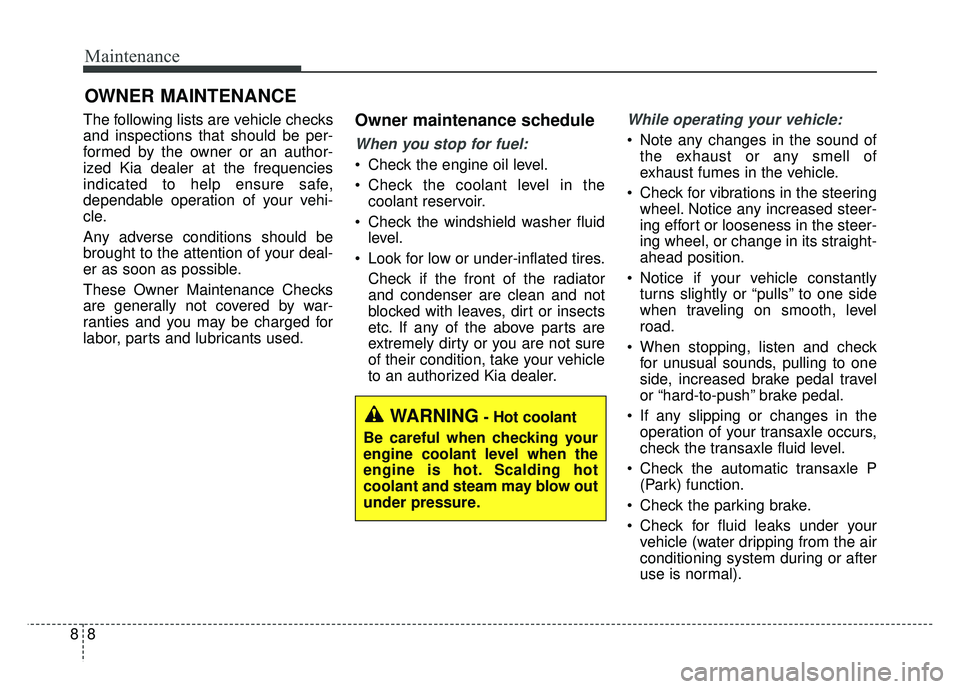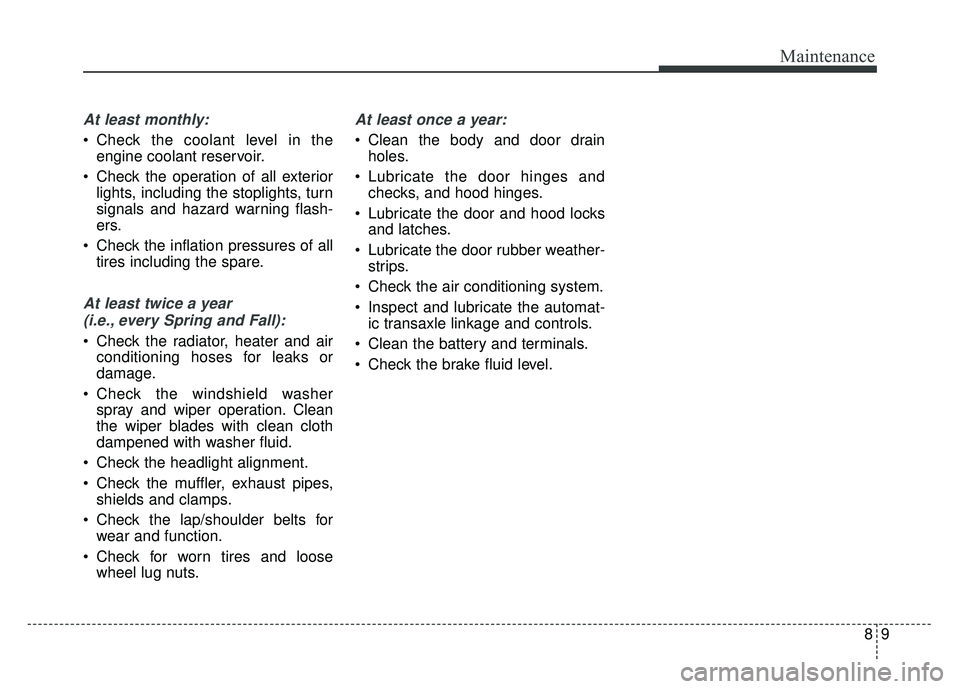Page 479 of 620
Maintenance
48
OPS076002N
* The actual engine room in the vehicle may differ from the illustration.1. Engine oil filler cap
2. Windshield washer fluid reservoir
3. Engine oil dipstick
4. Engine coolant reservoir
5. Radiator cap
6. Brake/clutch fluid reservoir
7. Positive battery terminal
8. Negative battery terminal
9. Fuse box
10. Air cleaner
■ ■Nu 2.0L GDI
Page 483 of 620

Maintenance
88
OWNER MAINTENANCE
The following lists are vehicle checks
and inspections that should be per-
formed by the owner or an author-
ized Kia dealer at the frequencies
indicated to help ensure safe,
dependable operation of your vehi-
cle.
Any adverse conditions should be
brought to the attention of your deal-
er as soon as possible.
These Owner Maintenance Checks
are generally not covered by war-
ranties and you may be charged for
labor, parts and lubricants used.Owner maintenance schedule
When you stop for fuel:
Check the engine oil level.
Check the coolant level in thecoolant reservoir.
Check the windshield washer fluid level.
Look for low or under-inflated tires. Check if the front of the radiator
and condenser are clean and not
blocked with leaves, dirt or insects
etc. If any of the above parts are
extremely dirty or you are not sure
of their condition, take your vehicle
to an authorized Kia dealer.
While operating your vehicle:
Note any changes in the sound ofthe exhaust or any smell of
exhaust fumes in the vehicle.
Check for vibrations in the steering wheel. Notice any increased steer-
ing effort or looseness in the steer-
ing wheel, or change in its straight-
ahead position.
Notice if your vehicle constantly turns slightly or “pulls” to one side
when traveling on smooth, level
road.
When stopping, listen and check for unusual sounds, pulling to one
side, increased brake pedal travel
or “hard-to-push” brake pedal.
If any slipping or changes in the operation of your transaxle occurs,
check the transaxle fluid level.
Check the automatic transaxle P (Park) function.
Check the parking brake.
Check for fluid leaks under your vehicle (water dripping from the air
conditioning system during or after
use is normal).
WARNING- Hot coolant
Be careful when checking your
engine coolant level when the
engine is hot. Scalding hot
coolant and steam may blow out
under pressure.
Page 484 of 620

89
Maintenance
At least monthly:
Check the coolant level in theengine coolant reservoir.
Check the operation of all exterior lights, including the stoplights, turn
signals and hazard warning flash-
ers.
Check the inflation pressures of all tires including the spare.
At least twice a year
(i.e., every Spring and Fall):
Check the radiator, heater and air conditioning hoses for leaks or
damage.
Check the windshield washer spray and wiper operation. Clean
the wiper blades with clean cloth
dampened with washer fluid.
Check the headlight alignment.
Check the muffler, exhaust pipes, shields and clamps.
Check the lap/shoulder belts for wear and function.
Check for worn tires and loose wheel lug nuts.
At least once a year:
Clean the body and door drainholes.
Lubricate the door hinges and checks, and hood hinges.
Lubricate the door and hood locks and latches.
Lubricate the door rubber weather- strips.
Check the air conditioning system.
Inspect and lubricate the automat- ic transaxle linkage and controls.
Clean the battery and terminals.
Check the brake fluid level.
Page 514 of 620
839
Maintenance
CHECKING FLUID LEVELS
When checking engine oil, engine
coolant, brake fluid, and washer fluid,
always be sure to clean the area
around any filler plug, drain plug, or
dipstick before checking or draining
any lubricant or fluid. This is espe-
cially important in dusty or sandy
areas and when the vehicle is used
on unpaved roads. Cleaning the plug
and dipstick areas will prevent dirt
and grit from entering the engine and
other mechanisms that could be
damaged.
Page 522 of 620
847
Maintenance
WASHER FLUID
Checking the washer fluid
level
The reservoir is translucent so that
you can check the level with a quick
visual inspection.Check the fluid level in the washer
fluid reservoir and add fluid if neces-
sary. Plain water may be used if
washer fluid is not available.
However, use washer solvent with
antifreeze characteristics in cold cli-
mates to prevent freezing.
OPS073006
OPS073007
■
Type A
■Type B
WARNING- Flammable
Fluid
Do not allow the washer fluid to
come in contact with open
flames or sparks. The windshield
washer fluid reservoir is flamma-
ble under certain circumstances.
This can result in a fire.
WARNING- Coolant
Do not use radiator coolant or antifreeze in the washer fluid
reservoir.
Radiator coolant can severely obscure visibility when sprayed
on the windshield and may
cause loss of vehicle control.
WARNING- Windshield
fluid
Do not drink the windshield
washer fluid. The windshield
washer fluid is poisonous to
humans and animals.
Page 618 of 620

Index
10I
Overview . . . . . . . . . . . . . . . . . . . . . . . . . . . . . . . . . 4-68
Trip A/B (for Type A cluster) . . . . . . . . . . . . . . . . . . 4-69
Vehicle Break-In Process . . . . . . . . . . . . . . . . . . . . . . . . 1-6
Vehicle certification label . . . . . . . . . . . . . . . . . . . . . . . 9-10
Vehicle data collection and event data recorders . . . . . . 1-7
Vehicle handling instructions . . . . . . . . . . . . . . . . . . . . . 1-6
Vehicle identification number (VIN) . . . . . . . . . . . . . . 9-10
Vehicle load limit . . . . . . . . . . . . . . . . . . . . . . . . . . . . 6-114 Certification label . . . . . . . . . . . . . . . . . . . . . . . . . . 6-118
Tire and loading information label. . . . . . . . . . . . . 6-114
Vehicle weight glossary . . . . . . . . . . . . . . . . . . . . . . . 6-120 Base curb weight . . . . . . . . . . . . . . . . . . . . . . . . . . 6-120
Cargo weight . . . . . . . . . . . . . . . . . . . . . . . . . . . . . 6-120
GAW (Gross axle weight) . . . . . . . . . . . . . . . . . . . 6-120
GAWR (Gross axle weight rating) . . . . . . . . . . . . . 6-120
GVW (Gross vehicle weight). . . . . . . . . . . . . . . . . 6-120
GVWR (Gross vehicle weight rating) . . . . . . . . . . 6-120
Vehicle curb weight . . . . . . . . . . . . . . . . . . . . . . . . 6-120
Warning and indicator lights. . . . . . . . . . . . . . . . . . . . . 4-74 Indicator Lights . . . . . . . . . . . . . . . . . . . . . . . . . . . . 4-82
Warning lights . . . . . . . . . . . . . . . . . . . . . . . . . . . . . 4-74 Washer fluid . . . . . . . . . . . . . . . . . . . . . . . . . . . . . . . . . 8-47
Checking the washer fluid level . . . . . . . . . . . . . . . . 8-47
Windows . . . . . . . . . . . . . . . . . . . . . . . . . . . . . . . . . . . . \
4-24 Power windows . . . . . . . . . . . . . . . . . . . . . . . . . . . . 4-52
Windshield defrosting and defogging. . . . . . . . . . . . . 4-128 Automatic climate control system . . . . . . . . . . . . . 4-129
Defogging logic . . . . . . . . . . . . . . . . . . . . . . . . . . . 4-130
Manual climate control system . . . . . . . . . . . . . . . 4-128
Winter driving . . . . . . . . . . . . . . . . . . . . . . . . . . . . . . . 6-110 Carry emergency equipment . . . . . . . . . . . . . . . . . 6-113
Change to “winter weight” oil if necessary . . . . . . 6-112
Check battery and cables . . . . . . . . . . . . . . . . . . . . 6-112
Check spark plugs and ignition system . . . . . . . . . 6-112
Don’t let your parking brake freeze . . . . . . . . . . . . 6-113
Don't let ice and snow accumulate underneath . . . 6-113
Snowy or icy conditions . . . . . . . . . . . . . . . . . . . . . 6-110
To keep locks from freezing. . . . . . . . . . . . . . . . . . 6-112
Use approved window washer anti-freeze in system. . . . . . . . . . . . . . . . . . . . . . . . . . . . . . . . . . 6-11\
2
Use high quality ethylene glycol coolant. . . . . . . . 6-112
Wiper blades . . . . . . . . . . . . . . . . . . . . . . . . . . . . . . . . . 8-52 Blade inspection . . . . . . . . . . . . . . . . . . . . . . . . . . . . 8-52
Blade replacement . . . . . . . . . . . . . . . . . . . . . . . . . . 8-52
V
W